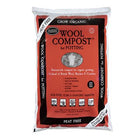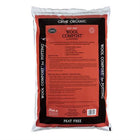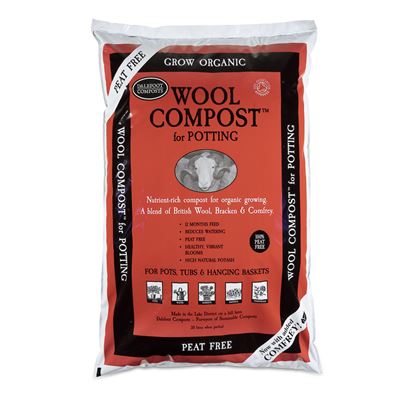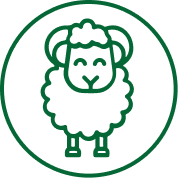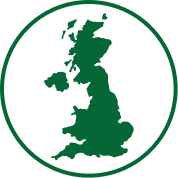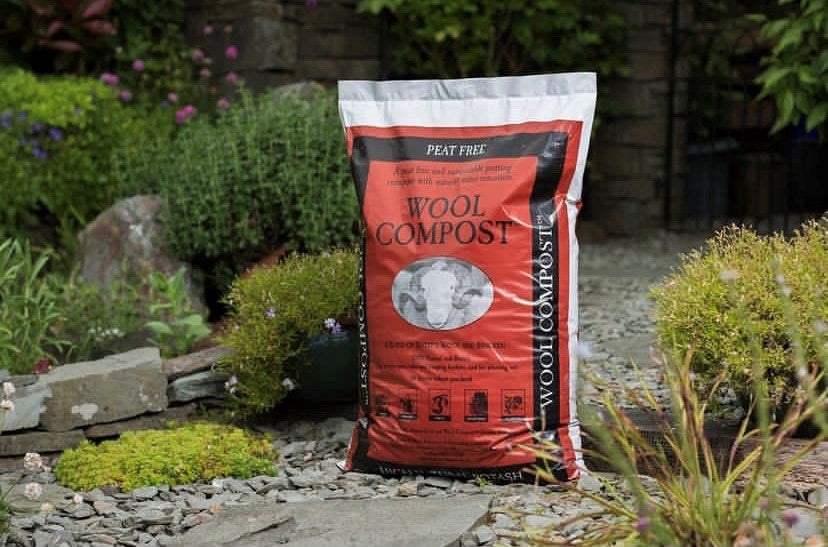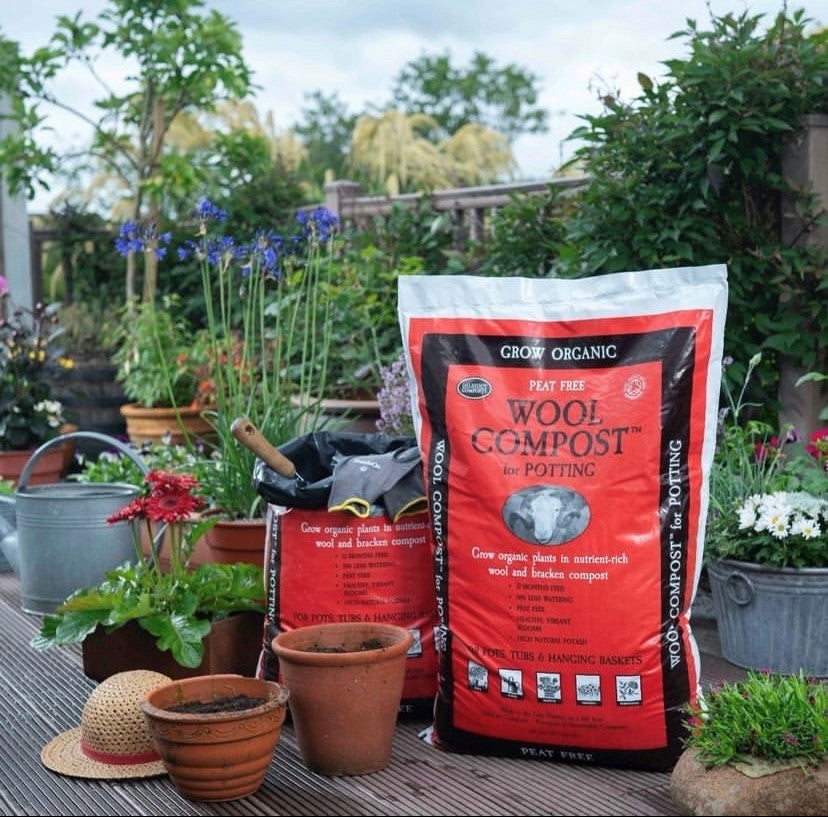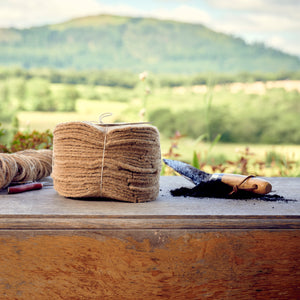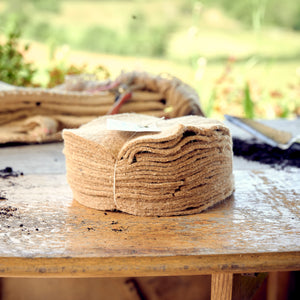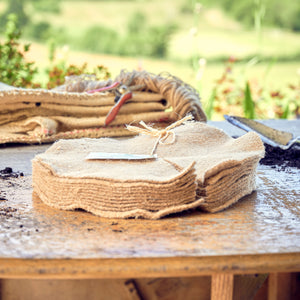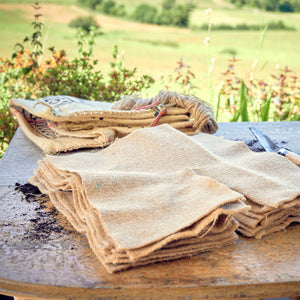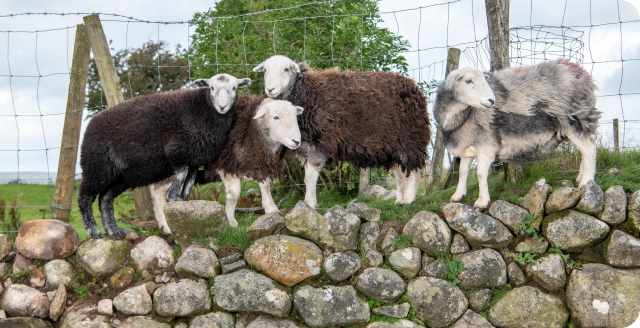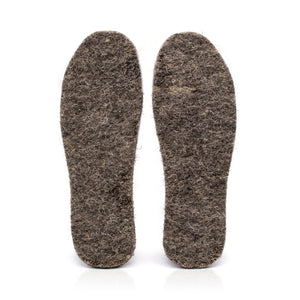Why is this Peat-Free Wool Compost so great?
This Peat-Free Wool Compost is brilliant and we’ve had great success with it in our own gardens. Here are a few reasons why it is so wonderful:
Completely peat-free – this compost is 100% peat-free which means it has great environmental benefits (you can read more about that below!). We have found that it works just as well, if not better, than compost containing peat and even has a similar soft texture.
Has added ‘Bocking 47’ Comfrey – Comfrey is an organic ‘dynamic accumulator’ packed with nutrients. ‘Bocking 47’ is the gold standard of Comfrey varieties as it contains very high levels of potassium, phosphorous and nitrogen all of which are essential for healthy plant growth, larger flowers and bigger crops.
Contains wool – like some of our other gardening products such as our garden felt and shillies, this compost contains WOOL! Wool is such a brilliant material to use in your garden for lots of reasons. In this compost specifically, wool helps the compost retain water naturally due to wool’s hygroscopic properties. The wool is also full of slow-releasing nitrogen which, as we already know, is really important for strong plant growth.
Includes bracken – bracken is FULL of potash (potassium) which is essential for fruiting and flowering. It also toughens growth in order to resist pests and diseases whilst increasing a plant’s resistance to drought or extreme cold.
No need to feed – due to all the wonderful ingredients of the compost we mentioned above, you don’t need to add any extra feed to this compost or any water-retaining gels either. You can plant and leave. Easy peasy!
Social Association approved – the compost is sustainably made from renewable, natural ingredients on Dalefoot Farm in the Lake District and is approved for organic growing by the Soil Association.
How can I use this Peat-Free Wool Compost?
This Peat-Free Wool Compost is a general-purpose compost and is ideal for use in growing in pots, tubs and hanging baskets where water retention is key. It also works really well directly into gardening beds – we’ve had great success with it in raised beds.
How to use the compost in pots, tubs and hanging baskets:
- If you are making up a hanging basket, we would suggest using one of our Jute Hanging Basket Liners which are super dense, are biodegradable but last long enough to use for several seasons. If you are just making up a pot or a tub, skip that step!
- Fill your container with the compost and water it in well.
- Then you can plant bedding or well-rooted seedlings directly into the compost. And, that’s it! Once you’ve planted them, you can leave them to flourish!
How to use the compost in garden beds:
- Fill your raised beds with the compost and water it in well.
- Directly plant your shrubs, flowering plants or vegetable plants into the compost.
- All done! You don’t need to add any fertilizers or plant feed into the compost because it is already packed with loads. If you have previously had a problem with slugs or weeds, then give our Jute Mulch Mats a go which will add an extra layer of protection.
What is peat?
Peat, as defined by the International Peatland Society, is “Peat is the surface organic layer of a soil that consists of partially decomposed organic matter, derived mostly from plant material, which has accumulated under conditions of waterlogging, oxygen deficiency, high acidity and nutrient deficiency”. It is formed in bogs, over thousands of years and is thick and muddy!
Peatlands make up around 12% of the UK and when in good condition store significant amounts of carbon, as well as providing a quarter of the UK’s drinking water and being rich in rare and endangered plants and animals.
Over the last century, the International Union for Conservation of Nature estimates 80% of the UK’s peatlands are in a damaged and deteriorating condition having been modified as a result of present and past land management activities, including extraction for horticulture and draining for agricultural improvement. This is bad news! Keep reading and we’ll explain why.
>Why is it important to protect peat?
As we mentioned above, peat takes many years to form which means that the loss of peat through harvesting for horticulture and agriculture is irreversible over human timescales. Using products containing peat is completely unsustainable.
Reducing the amount of peat in our environment could be detrimental because it plays such a number of important roles in our ecosystem:
-
Acts as a carbon store – peat is a brilliant carbon store. In upland blanket bogs, the predominant UK peatland type, the peat layer is typically 1–5 m thick and every square metre contains 40–200 kg of carbon. To put that into context, it is estimated that over 3 billion tonnes of carbon are stored in UK peatlands currently, which is equivalent to all the carbon stored in forests in the UK, Germany and France combined. On a global scale, the remaining areas of near-natural peatland) contains more than 550 gigatonnes of carbon. The world’s forests sequester about 0.37 gigatonnes of CO2 a year. Pretty mind-blowing right? However, when it is cultivated, the peat bogs start to dry out which releases the carbon stored as carbon dioxide into the environment. This, as well know, speeds up global warming and climate change – not good! Degraded UK peatland is responsible for around 5% of the UK’s greenhouse gas emissions. By retaining and establishing peat bogs we can not only help reduce our emissions but also start to capture the carbon that is being released into the environment in other forms.
-
Helps with water management – peat plays an important role in the hydrological cycle helping to maintain water quantity and quality. It can hold up to 20 times its own weight in water and according to the ONS, in the UK alone, peatland represents 27% of the UK ecosystem service accounts. Its ability to hold such huge amounts of water helps it to regulate water flows, playing a key role in flood prevention. This is something more and more of us in the UK (and globally) are suffering with due to the effects of global warming, and it is being made worse by the reduction of peat in our environment.
-
Provides important habitats – peat bogs provide unique, natural habitats for many scare species as well as a wide range of nationally and internationally important flora and fauna. They support species such as carnivorous sundew plants and uncommon insects like large heath butterflies, four-spotted chaser dragonflies and picture-winged bog craneflies. These have seen dwindling numbers due to the decrease in wet peatland areas which has a wider impact on our ecosystem.
- >Acts as a vital historic record of the land - peat contains vital and unique historical evidence of an area and its inhabitants. It preserves a record of past vegetation, pollen counts, landscaped and people. You may wonder why that is important? Well, for historical research it is very important but it also acts as a very good indicator of how the landscape has changed over the years and what we need to be doing to restore it.
So, as you can see, peat is very important to protect, and as consumers, we can help to protect it by choosing peat-free gardening products. In fact, the UK Government are committed to halting the use of peat in horticulture in England by 2030 and introduced a voluntary target for amateur gardeners to phase out the use of peat by 2020. There will also be a final voluntary phase-out target of 2030 for professional growers of fruit, vegetables and plants. So why wait? Make the change now! Many growers and producers of plants are now using this compost as an alternative to peat, with excellent results, so we promise, your garden will still be blooming beautiful when you make the switch.
Why is this Peat-Free Wool Compost so great?
This Peat-Free Wool Compost is brilliant and we’ve had great success with it in our own gardens. Here are a few reasons why it is so wonderful:
Completely peat-free – this compost is 100% peat-free which means it has great environmental benefits (you can read more about that below!). We have found that it works just as well, if not better, than compost containing peat and even has a similar soft texture.
Has added ‘Bocking 47’ Comfrey – Comfrey is an organic ‘dynamic accumulator’ packed with nutrients. ‘Bocking 47’ is the gold standard of Comfrey varieties as it contains very high levels of potassium, phosphorous and nitrogen all of which are essential for healthy plant growth, larger flowers and bigger crops.
Contains wool – like some of our other gardening products such as our garden felt and shillies, this compost contains WOOL! Wool is such a brilliant material to use in your garden for lots of reasons. In this compost specifically, wool helps the compost retain water naturally due to wool’s hygroscopic properties. The wool is also full of slow-releasing nitrogen which, as we already know, is really important for strong plant growth.
Includes bracken – bracken is FULL of potash (potassium) which is essential for fruiting and flowering. It also toughens growth in order to resist pests and diseases whilst increasing a plant’s resistance to drought or extreme cold.
No need to feed – due to all the wonderful ingredients of the compost we mentioned above, you don’t need to add any extra feed to this compost or any water-retaining gels either. You can plant and leave. Easy peasy!
Social Association approved – the compost is sustainably made from renewable, natural ingredients on Dalefoot Farm in the Lake District and is approved for organic growing by the Soil Association.
How can I use this Peat-Free Wool Compost?
This Peat-Free Wool Compost is a general-purpose compost and is ideal for use in growing in pots, tubs and hanging baskets where water retention is key. It also works really well directly into gardening beds – we’ve had great success with it in raised beds.
How to use the compost in pots, tubs and hanging baskets:
- If you are making up a hanging basket, we would suggest using one of our Jute Hanging Basket Liners which are super dense, are biodegradable but last long enough to use for several seasons. If you are just making up a pot or a tub, skip that step!
- Fill your container with the compost and water it in well.
- Then you can plant bedding or well-rooted seedlings directly into the compost. And, that’s it! Once you’ve planted them, you can leave them to flourish!
How to use the compost in garden beds:
- Fill your raised beds with the compost and water it in well.
- Directly plant your shrubs, flowering plants or vegetable plants into the compost.
- All done! You don’t need to add any fertilizers or plant feed into the compost because it is already packed with loads. If you have previously had a problem with slugs or weeds, then give our Jute Mulch Mats a go which will add an extra layer of protection.
What is peat?
Peat, as defined by the International Peatland Society, is “Peat is the surface organic layer of a soil that consists of partially decomposed organic matter, derived mostly from plant material, which has accumulated under conditions of waterlogging, oxygen deficiency, high acidity and nutrient deficiency”. It is formed in bogs, over thousands of years and is thick and muddy!
Peatlands make up around 12% of the UK and when in good condition store significant amounts of carbon, as well as providing a quarter of the UK’s drinking water and being rich in rare and endangered plants and animals.
Over the last century, the International Union for Conservation of Nature estimates 80% of the UK’s peatlands are in a damaged and deteriorating condition having been modified as a result of present and past land management activities, including extraction for horticulture and draining for agricultural improvement. This is bad news! Keep reading and we’ll explain why.
>Why is it important to protect peat?
As we mentioned above, peat takes many years to form which means that the loss of peat through harvesting for horticulture and agriculture is irreversible over human timescales. Using products containing peat is completely unsustainable.
Reducing the amount of peat in our environment could be detrimental because it plays such a number of important roles in our ecosystem:
-
Acts as a carbon store – peat is a brilliant carbon store. In upland blanket bogs, the predominant UK peatland type, the peat layer is typically 1–5 m thick and every square metre contains 40–200 kg of carbon. To put that into context, it is estimated that over 3 billion tonnes of carbon are stored in UK peatlands currently, which is equivalent to all the carbon stored in forests in the UK, Germany and France combined. On a global scale, the remaining areas of near-natural peatland) contains more than 550 gigatonnes of carbon. The world’s forests sequester about 0.37 gigatonnes of CO2 a year. Pretty mind-blowing right? However, when it is cultivated, the peat bogs start to dry out which releases the carbon stored as carbon dioxide into the environment. This, as well know, speeds up global warming and climate change – not good! Degraded UK peatland is responsible for around 5% of the UK’s greenhouse gas emissions. By retaining and establishing peat bogs we can not only help reduce our emissions but also start to capture the carbon that is being released into the environment in other forms.
-
Helps with water management – peat plays an important role in the hydrological cycle helping to maintain water quantity and quality. It can hold up to 20 times its own weight in water and according to the ONS, in the UK alone, peatland represents 27% of the UK ecosystem service accounts. Its ability to hold such huge amounts of water helps it to regulate water flows, playing a key role in flood prevention. This is something more and more of us in the UK (and globally) are suffering with due to the effects of global warming, and it is being made worse by the reduction of peat in our environment.
-
Provides important habitats – peat bogs provide unique, natural habitats for many scare species as well as a wide range of nationally and internationally important flora and fauna. They support species such as carnivorous sundew plants and uncommon insects like large heath butterflies, four-spotted chaser dragonflies and picture-winged bog craneflies. These have seen dwindling numbers due to the decrease in wet peatland areas which has a wider impact on our ecosystem.
- >Acts as a vital historic record of the land - peat contains vital and unique historical evidence of an area and its inhabitants. It preserves a record of past vegetation, pollen counts, landscaped and people. You may wonder why that is important? Well, for historical research it is very important but it also acts as a very good indicator of how the landscape has changed over the years and what we need to be doing to restore it.
So, as you can see, peat is very important to protect, and as consumers, we can help to protect it by choosing peat-free gardening products. In fact, the UK Government are committed to halting the use of peat in horticulture in England by 2030 and introduced a voluntary target for amateur gardeners to phase out the use of peat by 2020. There will also be a final voluntary phase-out target of 2030 for professional growers of fruit, vegetables and plants. So why wait? Make the change now! Many growers and producers of plants are now using this compost as an alternative to peat, with excellent results, so we promise, your garden will still be blooming beautiful when you make the switch.
